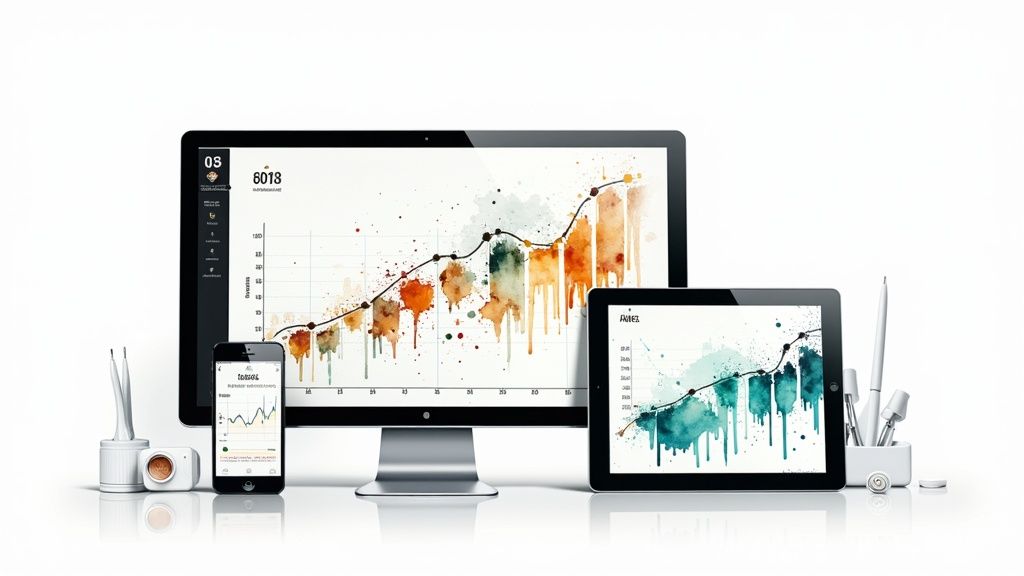Introduction

In marketing, a deep understanding of your audience, campaigns, and overall performance is crucial for success. This understanding stems from effectively analyzing your marketing data. Analyzing this data provides the necessary insights to navigate the market, optimize strategies, and achieve business objectives. It's more than just collecting numbers; it's about transforming raw data into actionable strategies. Imagine trying to navigate a city without a map – challenging, right? Similarly, executing marketing strategies without data analysis is like navigating blind.
Why is Marketing Data Analysis Important?
Data analysis helps marketers understand what strategies are working, what's falling short, and, importantly, why. For instance, analyzing website traffic can reveal which content resonates most with your audience, allowing you to create more engaging material. Analyzing social media engagement can pinpoint the best times and platforms to connect with your target demographic. This means you can allocate resources more effectively, maximizing your return on investment. However, collecting data is only the first step; the real power comes from analyzing it effectively. This involves understanding different data types, choosing the right tools, and interpreting the results meaningfully. This introduction sets the stage for exploring these critical steps, paving the way for data-driven success in your marketing efforts.
Types of Marketing Data
Understanding marketing data analysis begins with recognizing the different types of data available, from website activity to subtle customer behaviors. Just as a chef uses various ingredients, marketers need diverse data types to craft successful campaigns. These data points form the foundation for a comprehensive understanding of your target audience and marketing performance. Let's explore these different data categories and their contributions to insightful analysis.
First-Party Data: Your Gold Mine
First-party data is the information collected directly from your audience through interactions with your website, app, CRM, surveys, and other owned channels. This data provides valuable insights into their preferences, behaviors, and demographics. Purchase history, for example, reveals popular products, while website activity shows which content captures their attention. This direct access makes first-party data incredibly valuable for personalized marketing and accurate audience segmentation. This leads us to consider other valuable data sources.
Second-Party Data: Partnering for Insights
Think of second-party data as borrowing a friend's map – it offers a fresh perspective. This data comes from a trusted partner who shares their first-party data with you. This can expand your reach and provide insights into a similar target audience. A partnership with a complementary business, for instance, could provide access to customer demographics or buying behaviors, enriching your existing data. This collaborative approach enhances the depth and breadth of your data pool.
Third-Party Data: Broadening Your Perspective
Third-party data is collected from various web sources and aggregated by data providers. It offers a broad overview, like a regional map, but may lack the specific details of a local map. It can be useful for identifying market trends, expanding audience targeting, and reaching new potential customers. This broad scope can illuminate larger market dynamics and identify growth opportunities. However, prioritizing data quality and source reliability is key. Understanding these different data types is critical for effective marketing data analysis. Each type offers unique insights, building a comprehensive picture of your marketing landscape. Now, let's explore how to collect this data effectively.
Data Collection Methods

Understanding how to collect data is the next crucial step after understanding the different types of marketing data. Just as a chef gathers ingredients before cooking, marketers need the right data to create a successful analysis. The effectiveness of your analysis depends heavily on the quality and relevance of the data you collect. Let's delve into various methods for gathering data for insightful marketing analysis.
Utilizing Website Analytics Tools
Your website is a rich source of data, offering insights into user behavior, content performance, and overall effectiveness. Website analytics tools, like Google Analytics, provide a wealth of information about user interactions. You can track metrics like page views, bounce rates, time spent on each page, and conversion rates. This allows you to understand which content resonates, identify areas for improvement in user experience, and track campaign success. This information is fundamental for analyzing marketing data and optimizing your website.
Harnessing the Power of Social Media Insights
Social media platforms offer valuable data about audience engagement, demographics, and campaign performance. Each platform has its own analytics dashboards for tracking metrics like likes, shares, comments, and reach. You can analyze which content types perform best, identify optimal posting times, and understand your followers' demographics. Social listening tools can help monitor brand mentions and sentiment, providing insights into public perception. Understanding audience interaction is essential for refining your social media strategy and maximizing reach. Building on this understanding of online interactions, let's explore how customer relationship management plays a role.
Leveraging CRM Data for Personalized Marketing
CRM systems store valuable data about customer interactions with your business, including purchase history, customer service interactions, email engagement, and demographic information. This personalized data is invaluable for segmenting your audience, tailoring campaigns, and nurturing customer relationships. You can identify high-value customers, personalize email communications, and offer targeted promotions. Using CRM data effectively creates a more personalized and engaging customer experience, driving customer loyalty and increasing conversions. To further enrich our understanding, we'll explore direct customer feedback.
Conducting Surveys and Gathering Feedback
While website analytics and social media insights provide quantitative data, surveys and feedback forms offer qualitative insights into customer opinions and preferences. This direct feedback is invaluable for understanding customer needs, identifying areas for improvement, and gathering ideas for new products or services. By incorporating surveys into your data collection strategy, you gain a deeper understanding of your target audience and tailor your offerings accordingly. These data collection methods, combined with an understanding of different data types, provide the foundation for effective analysis. By effectively utilizing these techniques, you can gather the necessary insights to optimize marketing strategies, enhance customer experience, and achieve business objectives. Now let's explore the tools that can help you make sense of this data.
Analysis Tools and Software

Choosing the right tools and software is crucial for effective marketing data analysis. Just as a chef chooses the right appliances, selecting the right analytical tools streamlines your workflow and unlocks the full potential of your marketing data. This section explores popular and powerful options for marketing data analysis, each catering to different needs and levels of expertise. Let's begin with a foundational tool.
Spreadsheet Software: A Foundation for Basic Analysis
Spreadsheet software like Google Sheets or Microsoft Excel offers a readily accessible starting point for data analysis. These tools are ideal for organizing data, performing basic calculations, and creating simple charts and graphs. You can easily calculate click-through rates, conversion rates, and other key metrics using built-in formulas. Spreadsheets are a good option for initial data exploration and quick insights. However, they can become cumbersome with large datasets or complex analysis, highlighting the need for more powerful tools as your needs grow.
Business Intelligence (BI) Platforms: Unveiling Deeper Insights
Business intelligence (BI) platforms, such as Tableau, Power BI, and Google Data Studio, offer robust capabilities for visualizing and analyzing larger, more complex datasets. They provide advanced features for creating interactive dashboards, exploring data trends, and generating custom reports. You can create dashboards that track key performance indicators (KPIs) across different marketing channels, providing a holistic view of your performance. These tools often offer data integration capabilities, combining data from multiple sources into a single platform. This streamlined approach is invaluable for understanding the complete picture of your marketing data.
Marketing Analytics Platforms: Purpose-Built for Marketing Insights
Marketing analytics platforms like Google Analytics, HubSpot, and Adobe Analytics are specifically designed to track and analyze marketing data. They offer a wide range of features tailored to marketing needs, including website traffic analysis, campaign tracking, and audience segmentation. For example, you can analyze website traffic patterns to identify high-performing content and optimize for conversions. These tools often provide automated reporting, freeing up your time for strategic decision-making. This focus on marketing-specific metrics and reporting makes these platforms incredibly valuable.
Statistical Software Packages: Diving into Advanced Analysis
For advanced statistical analysis, software packages like R and Python offer powerful tools for data manipulation, modeling, and prediction. While requiring more technical expertise, they offer unparalleled flexibility and control. You can perform regression analysis to understand relationships between marketing variables and predict future outcomes, which is extremely valuable for strategic decisions and maximizing ROI. Now, let's explore how to effectively present your findings.
Data Visualization Techniques

Analyzing marketing data effectively depends not only on the tools used but also on how the data is presented. Data visualization techniques transform raw numbers into understandable and actionable insights. Effective visualization makes complex data accessible, revealing hidden trends and patterns. Let's explore key visualization techniques to communicate your findings effectively.
Choosing the Right Chart Type
Different data requires different visual representations. A line graph is effective for showing trends over time, like website traffic growth. A pie chart or bar graph is better for comparing market share across competitors. Scatter plots can reveal correlations between variables, such as ad spend and conversion rates. Choosing the right chart type is crucial for conveying your message clearly and accurately. This selection process ensures that your visuals effectively communicate the story within your data.
Telling a Story with Your Data
Data visualization is more than just creating charts; it's about telling a story. Think of your data as the plot, and your visualizations as the illustrations. Instead of just presenting sales figures, craft a narrative around the data, explaining contributing factors to the peaks and valleys. This narrative approach engages your audience and makes the data more memorable and impactful.
Using Color and Design Strategically
Color and design significantly impact the effectiveness of your visualizations. Contrasting colors can highlight key data points. A consistent design style across visualizations creates a cohesive and professional look. However, avoid using too many colors or overly complex designs, which can overwhelm the viewer. A well-designed visualization should be visually appealing and easy to interpret, guiding the viewer to the most important insights. This leads us to consider the power of interactive dashboards.
Interactive Dashboards: Empowering Exploration
Interactive dashboards enhance data visualization by allowing users to explore the data themselves. Like interactive maps, users can zoom in, filter data, and uncover hidden patterns. This empowers stakeholders to engage with the data meaningfully, fostering a deeper understanding of the insights. Enabling users to manipulate and filter data creates a dynamic and personalized experience, leading to more insightful analysis and data-driven decisions. This bridges the gap between raw data and actionable insights. Now, let's discuss how to turn these insights into action.
Actionable Insights

Understanding marketing data analysis culminates in extracting actionable insights – transforming raw data into concrete strategies that improve performance. Like a detective piecing together clues, marketers must analyze data to uncover hidden opportunities and address potential challenges. Let's explore how to translate data analysis into meaningful actions.
Identifying Key Performance Indicators (KPIs)
The first step in generating actionable insights is identifying Key Performance Indicators (KPIs) aligned with your objectives. If your goal is brand awareness, focus on metrics like website traffic, social media engagement, and reach. If your objective is driving sales, prioritize metrics like conversion rates, average order value, and customer lifetime value. This focused approach ensures you're analyzing the data that truly matters. Choosing the right KPIs acts as a filter, focusing on the most relevant data points.
Recognizing Trends and Patterns
After identifying your KPIs, look for trends and patterns in the data. Data visualization techniques are particularly helpful here. A consistent upward trend in website traffic could indicate the success of your content marketing strategy. A sudden drop in conversion rates might signal a website usability issue. By carefully examining the data, you can identify areas for improvement and areas of excellence. This diagnostic approach is essential for informed decision-making. Read also: How to master effective content marketing strategies. This understanding of trends and patterns sets the stage for translating insights into action.
Turning Insights into Action
Identifying trends is just the beginning; the real value lies in translating insights into concrete actions. If you discover one social media platform is driving significantly more website traffic, allocate more resources to that platform. If a specific content type resonates well with your audience, create more of that content. This proactive approach is crucial for adapting to the ever-changing marketing landscape and staying ahead of the competition. This iterative process of analysis and action is key to effective marketing data analysis. By consistently applying these principles, you can transform data into a dynamic driver of marketing success.
Aeon, a video creation platform, can help you capitalize on these data-driven insights. Transform your text, video, and audio content into engaging videos that resonate with your audience. Visit Aeon today and discover how you can elevate your content marketing strategy.